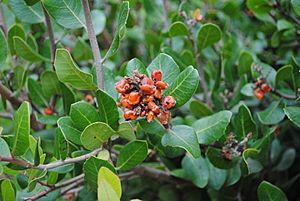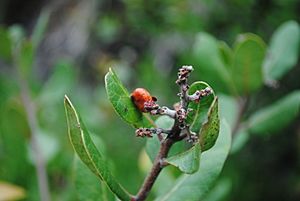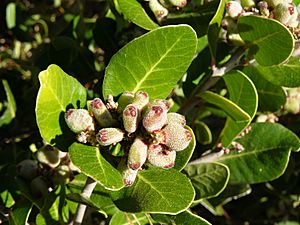Lemonade sumac facts for kids
Quick facts for kids Lemonade sumac |
|
|---|---|
 |
|
| Rhus integrifolia: Lemonade berry, fruit and leaves | |
| Scientific classification | |
| Genus: |
Rhus
|
| Species: |
integrifolia
|
 |
|
| Natural range | |
The Lemonadeberry (scientific name: Rhus integrifolia) is a cool plant that can be a shrub or a small tree. People also call it lemonade sumac or lemonade berry. It grows naturally in Southern California, especially in places like the Transverse Ranges, Peninsular Ranges, and along the South Coast. You can find it from Santa Barbara County and the Channel Islands all the way down to San Diego County. It even grows in northern Baja California and on islands like Cedros Island.
This plant usually grows about 1 to 8 meters (3 to 26 feet) tall. It often spreads out wide. Lemonadeberry is part of a plant group called chaparral. You can often spot it in canyons and on slopes that face north, especially below 900 meters (about 3,000 feet) in elevation. Sometimes, the Lemonadeberry mixes its genes with another plant called the Sugar sumac (Rhus ovata).
Contents
What Does the Lemonadeberry Look Like?
Lemonadeberry leaves are special because they are simple, not divided into three parts like many other plants in its family. They grow one after another along the stem. These leaves are evergreen, meaning they stay green all year, and feel a bit leathery. They are about 2 to 4 centimeters (1 to 1.5 inches) wide and 5 to 7 centimeters (2 to 3 inches) long. The leaves have a waxy, smooth look on top and are lighter underneath. Their edges are slightly toothed.
Flowers and Fruit
The flowers of the Lemonadeberry appear from February to May. They are small and grow close together in clusters. These flowers can have both male and female parts, or just female parts. They are round and have five green sepals (leaf-like parts under the petals), five white to pink petals, and five stamens (the male parts). Each tiny flower is only about 6 millimeters (0.2 inches) across.
The ripe fruit of the Lemonadeberry is sticky and reddish. It's covered with tiny hairs and is about 7 to 10 millimeters (0.3 to 0.4 inches) wide. These oval-shaped fruits grow in tight bunches at the very ends of the twigs.
Bark and Branches
Young Lemonadeberry plants have smooth, reddish bark. As the plant gets older, its bark becomes cracked and grayish. However, you can often still see the smooth red bark underneath. The twigs are quite strong and bendy. The buds at the ends of the twigs are small and pointy. This plant often has many branches growing from its base. A fully grown Lemonadeberry plant can be very large and bushy, spreading out widely.
Where Does the Lemonadeberry Grow?
The Lemonadeberry plant likes to grow on slopes that face north and east, and in canyon bottoms. You'll find it in coastal areas of Southern California and northern Baja California. One group of these plants has even been seen as far north as Santa Cruz County. Lemonadeberry is found in two main plant communities: chaparral and coastal sage scrub.
This plant grows best in soil that drains water well. It can handle hot and windy weather. It's happy in sandy soil, medium loam soils, and even in soil that doesn't have many nutrients. It can also grow in soils that are slightly acidic or slightly alkaline. It's common in shady, moist spots on north and east-facing slopes. New plants can grow from seeds or from underground stems called rhizomes. Birds love to eat the fruits, which helps spread the seeds to new places.
The Lemonadeberry doesn't like frost. However, it can mix with the Sugar sumac (Rhus ovata), which can handle frost. This happens in the foothills of California and Mexico where both plants grow.
How People Use Lemonadeberry
Many plants in the Rhus family can cause skin irritation for some people. However, the berries of the Lemonadeberry plant are often used to make drinks that taste like lemonade! This is how the plant got its common name.
Lemonadeberry leaves have a lot of tannins. Even though it's an evergreen plant, some leaves fall off in the autumn. These fallen leaves can be used to make a brown dye or to help other dyes stick to fabric. An oil can be taken from the Lemonadeberry seeds. This oil becomes thick like tallow when it sits. People can then use this oil to make candles. These candles burn brightly, but they might have a strong smell. The wood from older Lemonadeberry plants is hard and dense, making it good for starting fires in a fireplace.
Growing Lemonadeberry in Gardens
Rhus integrifolia is also a great plant for gardens. It can be used as a shrub or shaped into a hedge. It's also good for espalier, where you train a plant to grow flat against a wall. This plant can be hurt by frost, but it often grows back by summer, even if it looks like it died from the cold. It grows slowly to moderately. In a garden, this plant is quite resistant to deer. It also provides nectar and fruit for birds and nectar for butterflies. To grow it well, you should give it good drainage and not too much water in the summer, just like its natural home.
Images for kids
See also
 In Spanish: Rhus integrifolia para niños
In Spanish: Rhus integrifolia para niños






